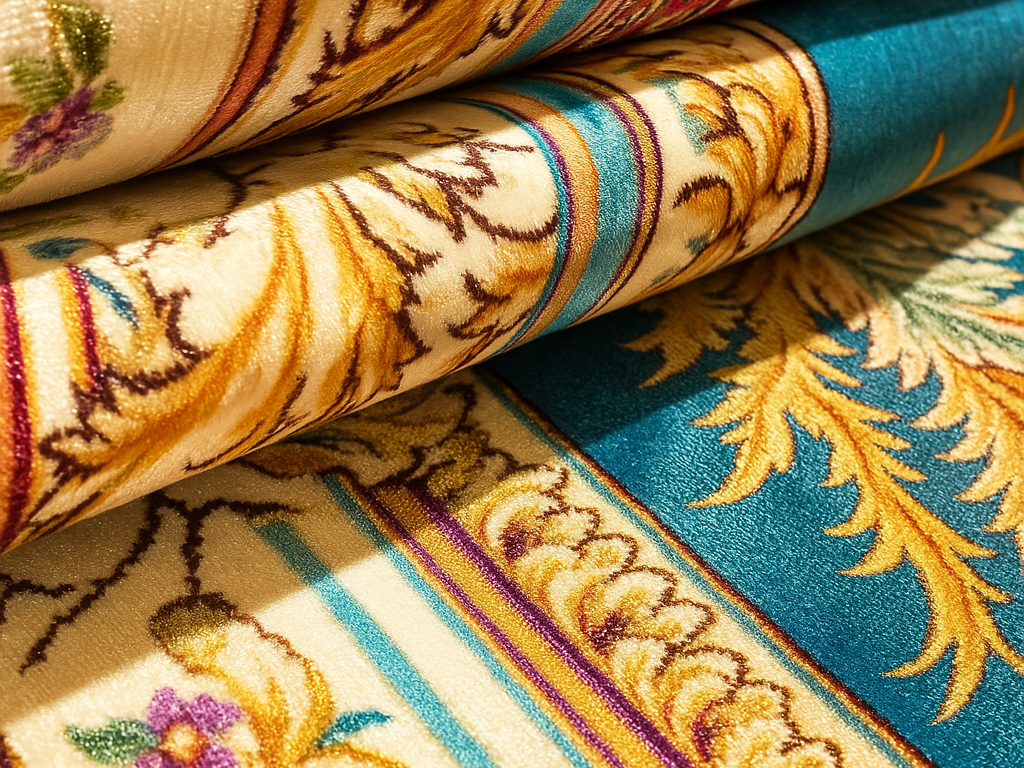Sind Sie hin- und hergerissen zwischen Teppichfliesen und Teppichboden für Ihren Büroboden? Ganz gleich, ob Sie Wert auf ein angenehmes Laufgefühl, nahtlose Ästhetik, Pflegeleichtigkeit oder Kosteneffizienz legen, Ihre Entscheidung hängt davon ab, wie die einzelnen Optionen abschneiden.

In diesem umfassenden Leitfaden gehen wir ausführlich auf die Vor- und Nachteile beider Arten von Teppichböden ein und helfen Ihnen dabei, herauszufinden, welcher Büroteppich für Ihre Räumlichkeiten wirklich am besten geeignet ist. Sie werden nicht nur lernen was unterscheidet sie von anderen, aber wenn Jedes einzelne Produkt glänzt und macht Ihre Wahl klar, selbstbewusst und perfekt auf die Bedürfnisse Ihres Arbeitsplatzes zugeschnitten.
1. Was sind Teppichböden und Teppichfliesen?
Breitflor, auch bezeichnet als Teppichboden, wird auf einem breiten Webstuhl hergestellt und in großen Rollen verkauft - in der Regel 12 bis 15 Fuß breit. Vielleicht erinnern Sie sich, dass die traditionellen Webmethoden zu seinem Namen geführt haben: “Breitwebstuhl”. Es handelt sich um einen nahtlosen Bodenbelag, der unbestreitbar luxuriös ist und oft über einer separaten Unterlage verlegt oder direkt auf dem Unterboden befestigt wird.
Teppichboden Fliesen-auch bekannt als modulare Teppichböden oder Teppichquadrate- werden als vorgefertigte Quadrate geliefert, in der Regel mit integriertem Rücken und Polsterung. Ursprünglich ein Verschnitt von Teppichböden, haben sie sich zu einer designorientierten, flexiblen Bodenbelagslösung entwickelt.
2. Die Vor- und Nachteile von Teppichböden mit Teppichboden
Wenn es darum geht Büroteppichboden, Der Teppichboden - auch als Teppichboden bekannt - ist seit langem ein Klassiker. Doch er hat seine Tücken, die oft unbemerkt bleiben.
Vorteile von Teppichböden mit Teppichboden
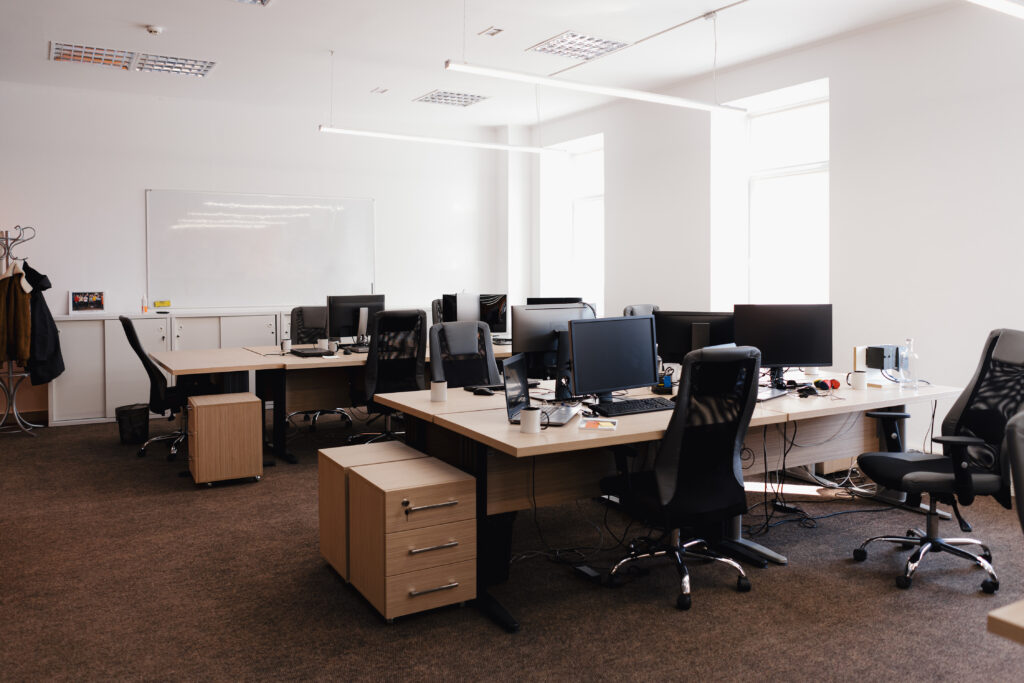
Nahtloses, elegantes Erscheinungsbild
Broadloom-Teppichböden verwandeln einen Raum mit einer glatten, durchgehenden Oberfläche. Die Nähte sind nahtlos verschweißt und schaffen einen ununterbrochenen visuellen Fluss, der selbst die einfachste Büroeinrichtung aufwertet - besonders in Chefetagen oder formellen Fluren.
Plüschiger Komfort unter den Füßen
Über die Ästhetik hinaus bietet Teppichboden spürbaren Komfort. Da er in der Regel über einer dickeren Unterlage verlegt wird, bietet er ein weiches, gepolstertes Gefühl - ideal für Bereiche, in denen sich Menschen aufhalten, wie Empfangsbereiche oder private Büros.
Kostenvorteil für große Räume
In großzügigen Räumen ist der Materialpreis pro Quadratmeter bei Teppichböden oft niedriger. Wenn Sie Großraumbüros oder Besprechungsräume ausstatten, können die Kosten durch die Verwendung von Teppichböden sogar erheblich gesenkt werden.
Subtile Integration der Nähte
Obwohl in breiteren Räumen mehrere Rollen erforderlich sein können, sorgen industrielle Verfahren wie das chemische Schweißen dafür, dass die Nähte praktisch verschwinden und die Illusion eines einzigen, zusammenhängenden Belags entsteht.
Optionen für feuchtigkeitsunempfindliche Rückseiten
Bestimmte hochwertige Teppichböden sind mit einer feuchtigkeitsresistenten Rückseite ausgestattet. Dies erhöht die Haltbarkeit in feuchten Zonen und bietet etwas mehr Widerstand als einige modulare Fliesensysteme.
Nachteile von Teppichböden mit Teppichboden
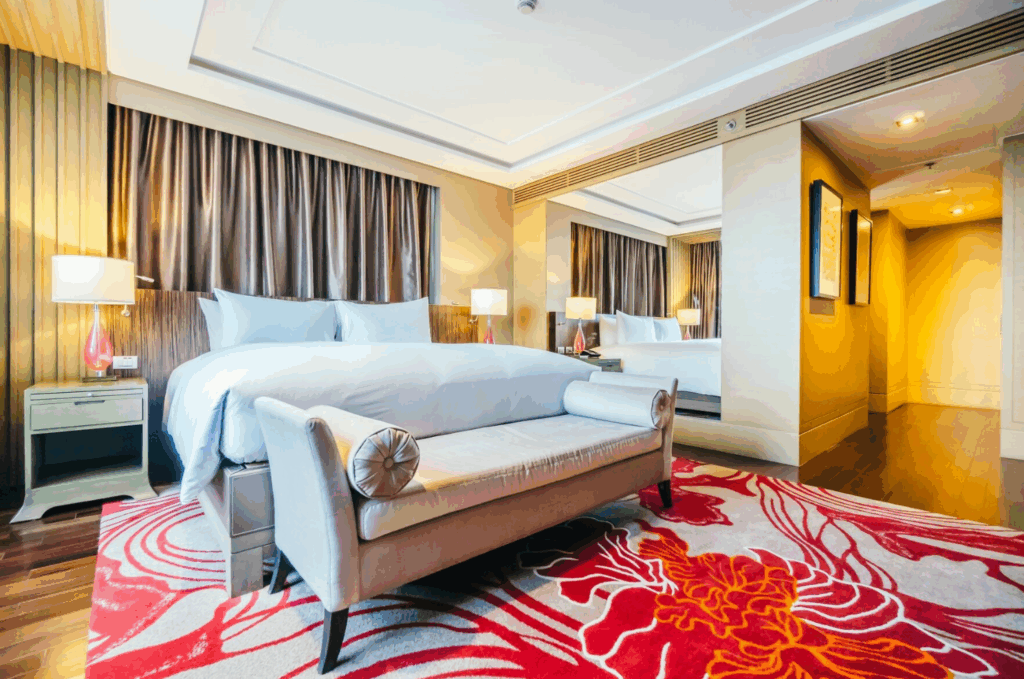
Arbeitsintensive, komplizierte Installation
Das Verlegen von Teppichböden ist kein schnelles Wochenendprojekt. Präzision ist das A und O: Die Maße müssen genau stimmen, die Zuschnitte müssen fluchten und die Polsterung muss richtig verlegt werden. Oft sind Profis mit Spreizern und Nahtwerkzeugen gefragt - und es braucht Zeit.
Materialabfälle beim Schneiden
Die Schönheit einer nahtlosen Rolle hat ihren Preis: überstehende Ränder. Beim Zuschneiden werden Material- und Polsterungsreste oft zu unbrauchbarem Abfall, der versteckte Kosten verursacht und der Nachhaltigkeit schadet.
Reparieren oder Ersetzen ist kostspielig
In den meisten Fällen ist ein Fleck oder eine Beschädigung nicht mit einem kleinen Flicken zu beheben. Da man einen Abschnitt nicht einfach isolieren und ersetzen kann, muss man bei Verschleiß oft ganze Abschnitte ersetzen - nicht ideal für knappe Budgets.
Wartung kann mühsam sein
Während das Staubsaugen einfach ist, erfordern tiefe Flecken eine Dampfreinigung oder eine professionelle Behandlung - und schmutzige Stellen heben sich auf der einheitlichen Oberfläche stärker ab.
Weniger nachhaltig - Herausforderungen beim Recycling
Teppichboden endet normalerweise auf einer Mülldeponie. Im Gegensatz zu vielen Teppichfliesen ist er aufgrund seiner Größe, des Trägermaterials und des schichtweisen Aufbaus normalerweise nicht recycelbar.
Was Leute aus der Praxis sagen
Reale Erfahrungen runden die Sache ab:
“So schlecht, wie manche Webstoffe heutzutage gemacht zu sein scheinen, hasse ich es, wenn ich versuche, sie mit Mustern zu versehen. Zwischen den Bögen, das Ändern der Abstände zwischen den Merkmalen, wenn man in die Rolle kommt ... es gut zu machen, scheint mehr Mühe zu sein, als die meisten Leute bereit sind, dafür zu bezahlen.” - ein Bodenbelagsverleger auf Reddit, der die Kopfschmerzen einer professionellen Verlegung beschreibt
3. Die Vor- und Nachteile von Teppichfliesen
Teppichfliesen - manchmal auch als modulare Teppiche bezeichnet - bringen einen dynamischen, praktischen Aspekt in den Bodenbelag von Büros. In diesem Artikel gehen wir der Frage nach, was sie auszeichnet (und wo sie versagen), und zwar in natürlichem Rhythmus und aus der Perspektive der Praxis.
Vorteile von Teppichfliesen
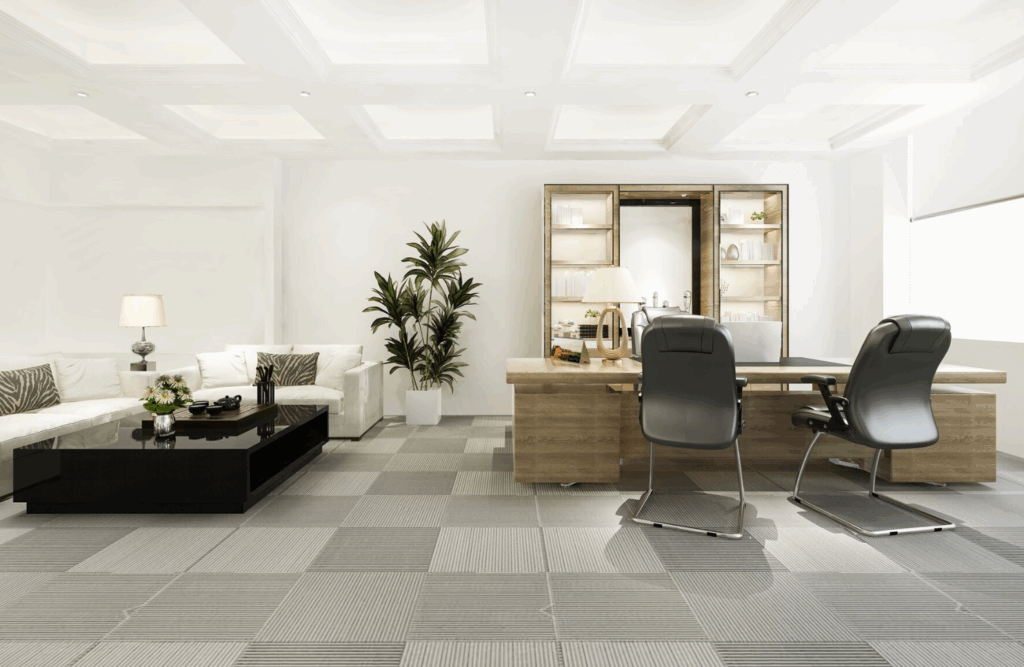
Einfache und schnelle Installation
Teppichfliesen sind kompakt, leicht und verfügen oft über eine abziehbare oder selbstklebende Rückseite, die es praktisch jedem ermöglicht, sie zu verlegen - sogar Heimwerkern - ohne Werkzeug zu schleppen oder mit sperrigen Rollen zu hantieren.
Rationalisierte Ersetzung und Wartung
Wenn eine Fliese verschmutzt oder beschädigt ist, können Sie sie einfach herausnehmen und ersetzen - der gesamte Boden muss nicht erneuert werden. Das macht Teppichfliesen zu einer intelligenten, budgetschonenden Wahl für die Instandhaltung viel beschäftigter Büros.
Inspirierende Design-Flexibilität
Von schlichten Monochromen bis hin zu gewagten Mustern - mit Fliesen können Sie kreativ werden. Mischen Sie Farben, Texturen und Layouts - Schachbrettmuster, Richtungswechsel, sogar Logos. Einige moderne Färbemethoden ermöglichen nahtlos wirkende Designs über die Fliesenkanten hinweg. (QuelleFloor, Milliken Blog).
Langlebigkeit und eingebaute Widerstandsfähigkeit
Viele Teppichfliesen sind für eine starke Beanspruchung ausgelegt - verstärkte Rückenbeschichtungen widerstehen dem Ausfransen, die Nähte bleiben stabil, und die Widerstandsfähigkeit bei hoher Beanspruchung ist eingebrannt.
Umweltverträglich und nachhaltig
Fliesen stehen für Nachhaltigkeit. Viele von ihnen werden aus recycelten Materialien hergestellt, sind selbst recycelbar und reduzieren den Installationsabfall drastisch. Außerdem lässt sich ihr Lebenszyklus durch modulare Ersatzlösungen verlängern. (SourceFloor, Sanford Carpet und Benutzerinformationen von Reddit: “Kommerzieller Teppichboden Fliesen haben eine Lebensdauer von bis zu 20 Jahren... werden getrennt, zerkleinert und zu neuen recycelten Teppichfliesen verarbeitet.”).
Akustische und komfortable Vorteile
Die gepolsterten Fliesen dämpfen Geräusche und verringern die Rutschgefahr - ein Segen in Großraumbüros. Außerdem bieten sie Halt unter den Füßen und verringern so die Ermüdung in Stehbereichen.
Unterstützung für Kreislaufwirtschaft
Ein Reddit-Nutzer hebt einen entscheidenden Vorteil hervor:
“Gewerbliche Teppichfliesen haben eine Lebensdauer von bis zu 20 Jahren. Wenn sie noch in gutem Zustand sind, werden sie wiederverwendet ... Wenn sie unbrauchbar sind, werden sie zu neuen recycelten Teppichfliesen verarbeitet.”
Nachteile von Teppichfliesen
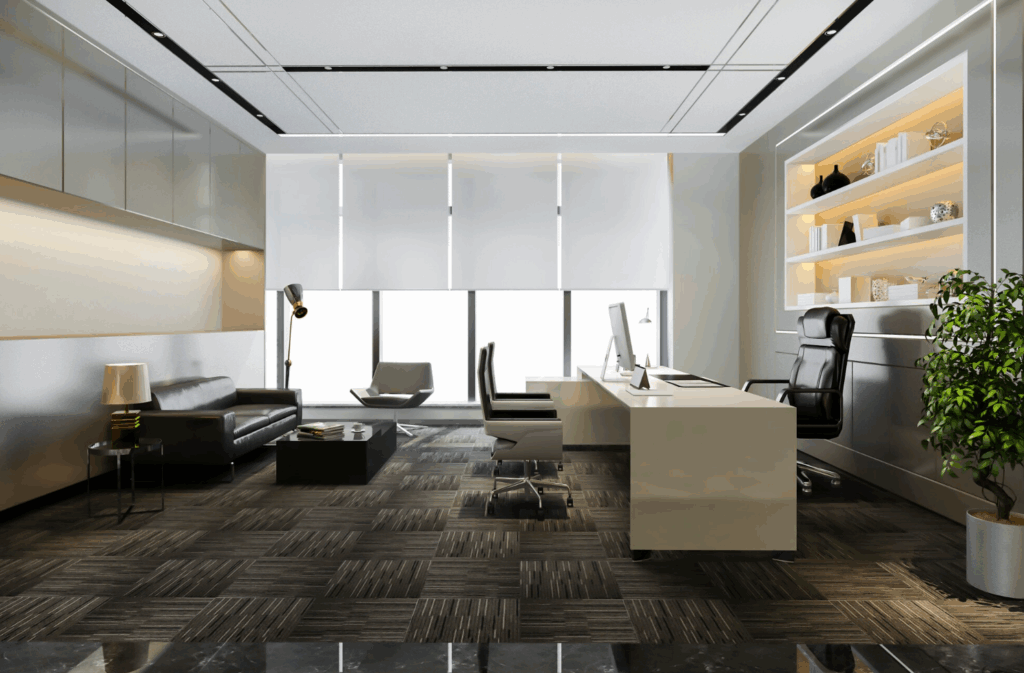
Höhere Vorabkosten
Die Bequemlichkeit der einzelnen Fliesen ist oft mit einem höheren Preis im Vergleich zu Teppichböden verbunden, aber die langfristigen Einsparungen bei der Pflege können dies ausgleichen.
Sichtbare Nähte und Raster Auswirkungen
Anders als bei der nahtlosen Ausdehnung von Teppichböden sind Fliesenfugen inhärente - und manchmal offensichtliche - Merkmale. Selbst eine präzise Verlegung bringt Sie optisch nur bedingt weiter.
Festes Gefühl unter den Füßen
Mit vormontierten dünnen Unterlagen (oder manchmal ohne) fühlen sich Fliesen im Allgemeinen fester an als Plüschböden mit dicker Polsterung.
Potentialverschiebung oder Kantenverkrümmung
Wenn die Fliesen nicht ordnungsgemäß verlegt und geklebt werden, können sie sich im Laufe der Zeit verschieben oder an den Rändern einrollen, was zu einem erhöhten Wartungsbedarf und möglichen Stolperfallen führt.
Gummiunterlage Verformung
Bestimmte Sorten - auch solche mit Gummiunterlage - können sich bei großer Hitze oder Feuchtigkeit verziehen, was sowohl das Aussehen als auch die Stabilität beeinträchtigt.
Stil-Wahrnehmung
Manche empfinden Teppichfliesen als zweckmäßig - ideal in Büros oder im Einzelhandel -, aber weniger gemütlich oder elegant in Wohnräumen. Ein durchdachtes Design trägt dazu bei, dies abzumildern.
Ausfransen der Kanten und Ausrichtungsfehler mit der Zeit
Bei wiederholter Abnutzung oder minderwertigen Kanten kann es zum Ausfransen oder Ziehen kommen, wodurch die Nähte hervorstechen oder ungleichmäßig aussehen. Eine sorgfältige Verlegung und gute Materialien sind hilfreich, aber es ist ein Risiko.
DIY-Grenzen
Auch wenn die Verlegung von Fliesen einfacher ist als die von Teppichböden, können komplizierte Grundrisse oder detaillierte Layouts dennoch professionelles Können erfordern, um sie sauber auszuführen.
Was die Benutzer sagen
Eine ehrliche Anmerkung aus der Praxis:
“Ich habe diese Teppichfliesen verlegt... Null Bewegung. Ich habe diese Teppichfliesen verlegt... sie sind vollständig entfernbar (und wiederverwendbar)... 10/10 würde ich empfehlen.” Und eine warnende Stimme: “In stark frequentierten Bereichen waren sie innerhalb von 8 Monaten abgenutzt... die Nähte waren sehr offensichtlich.”
4. Wann sollte man sich für Teppichböden mit breitem Bodenbelag entscheiden?
Um zu wissen, wann ein Teppichboden mit breitem Bodenbelag die beste Wahl für Ihre Büroräume ist, braucht es mehr als nur ein gutes Bauchgefühl - es geht darum, Aussehen, Haptik, Leistung und sogar Markenidentität in Einklang zu bringen. Hier ist eine Aufschlüsselung, wo Broadloom wirklich glänzt.
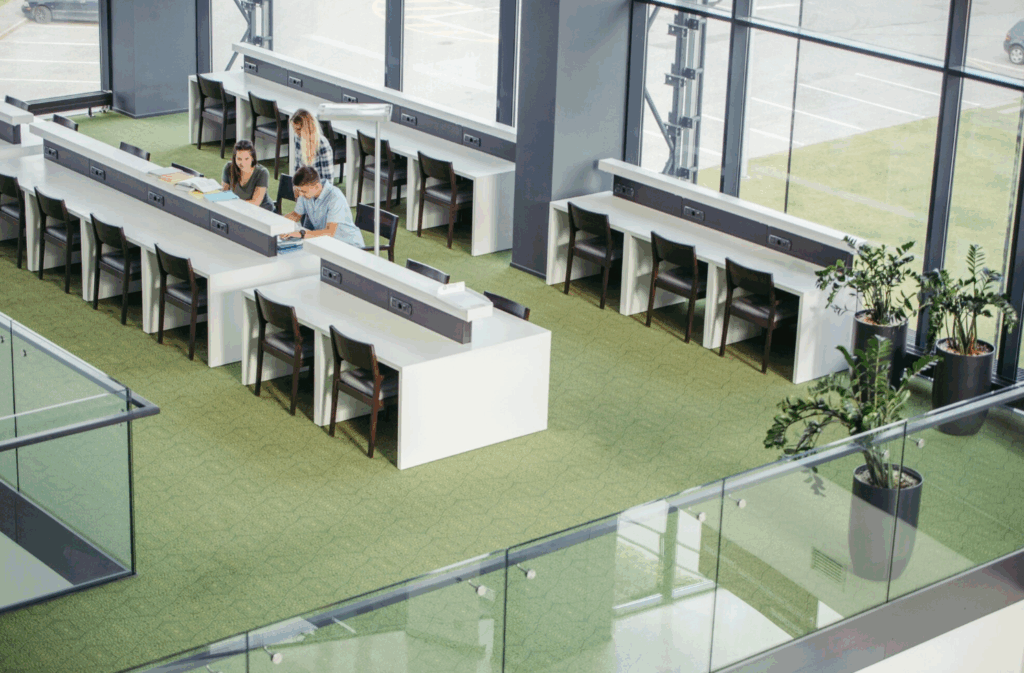
Räume, in denen ästhetische Nahtlosigkeit am wichtigsten ist
Broadloom bietet eine anspruchsvolle, ununterbrochene Oberfläche - ideal für Bereiche, in denen visuelle Kontinuität ebenso wichtig ist wie die Funktion. Denken Sie an Hotellobbys, Vorstandssuiten oder Sitzungssäle. Dies sind Räume, die von Zusammenhalt leben, wo sichtbare Nähte das Erlebnis stören würden.
Plüschkomfort und akustische Isolierung
Teppichböden liegen in der Regel auf einer dickeren Unterlage und absorbieren den Schall viel besser als dünne modulare Fliesen. Er ist die erste Wahl für Umgebungen, in denen Weichheit und Ruhe die Konzentration fördern - Cafés, Lounges oder private Büros.
Große, offene Räume, die ein einheitliches Erscheinungsbild erfordern
Die nahtlose Abdeckung großer Flächen trägt dazu bei, eine visuell ruhige Umgebung zu erhalten. Konferenzsäle, Großraumbüros oder andere Räume, in denen die Kontinuität des Dekors eine wichtige Rolle spielt, profitieren in hohem Maße von der durchgängigen Verlegung von Teppichböden.
Entwerfen mit großflächigen Mustern oder benutzerdefinierten Stilen
Teppichboden bietet kreativen Freiraum: denken Sie an kühne, aussagekräftige Grafiken, Medaillons oder komplizierte Texturen. Bestimmte Branchen, wie das Gastgewerbe und Luxusunternehmen, wissen diesen Vorteil besonders zu schätzen.
Gastgewerbe, Seniorenwohnungen und hochwertige Unternehmensräume
Diese Umgebungen legen Wert auf Komfort, Eleganz und Haltbarkeit. Teppichböden, insbesondere aus hochwertigen Fasern wie Woll-Nylon-Mischungen, erfüllen diese Anforderungen mit einer gehobenen Ästhetik und einem weichen Gefühl unter den Füßen.
Wenn Komfort und Markenerlebnis im Mittelpunkt stehen
In Räumen, in denen das Wohlbefinden der Kunden oder Mitarbeiter zur Wertschätzung beiträgt - wie in Anwaltskanzleien, Flughafen-Lounges und gehobenen Büros - übertrifft der Teppichboden oft die Fliesen, da er sowohl Wärme als auch Statur bietet.
Wenn Mängel des Unterbodens durch eine Unterlage kaschiert werden können
Die Unterlage von Broadloom ist nachsichtig. Fehler oder niedrige Stellen im Boden können verdeckt werden, was die Vorbereitungsarbeit reduziert - besonders nützlich in älteren Gebäuden oder bei kostensensiblen Renovierungen.
5. Wann sollte man Teppichfliesen wählen?
Teppichfliesen, auch bekannt als modulare Teppichböden, bieten eine vielseitige und praktische Bodenlösung für verschiedene Büroumgebungen. Wenn Sie wissen, wann Sie sich für Teppichfliesen entscheiden sollten, können Sie eine fundierte Entscheidung treffen, die auf die Bedürfnisse und Ziele Ihres Raums abgestimmt ist.
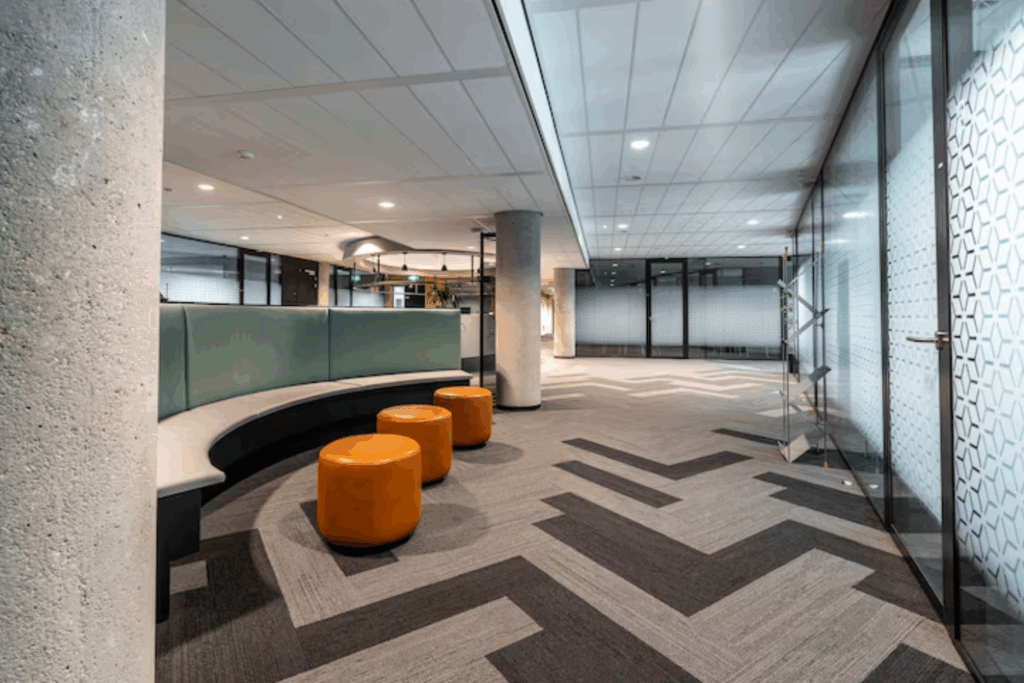
Hochfrequentierte Bereiche
Teppichfliesen sind so konstruiert, dass sie starkem Fußgängerverkehr standhalten, was sie ideal für Bereiche wie Flure, Großraumbüros und Empfangsbereiche macht. Ihre Langlebigkeit sorgt dafür, dass sie ihr Aussehen und ihre Funktionalität über lange Zeit beibehalten, selbst in belebten Umgebungen.
Einfache Installation und Wartung
Einer der herausragenden Vorteile von Teppichfliesen ist ihre einfache Verlegung und Pflege. Im Gegensatz zu herkömmlichen Teppichböden, die eine professionelle Verlegung erfordern, können Teppichfliesen oft von firmeninternen Teams verlegt werden, was Arbeitskosten und Ausfallzeiten reduziert. Wenn eine Fliese beschädigt oder verschmutzt wird, kann sie zudem leicht ausgetauscht werden, ohne dass der gesamte Teppichboden ersetzt werden muss. Dies führt zu Kosteneinsparungen und minimalen Unterbrechungen.
Flexibilität bei der Gestaltung
Teppichfliesen bieten eine breite Palette von Farben, Mustern und Strukturen, die es Ihnen ermöglichen, individuelle Designs zu entwerfen, die Ihre Markenidentität widerspiegeln und die Ästhetik Ihrer Büroräume verbessern. Ganz gleich, ob Sie ein einheitliches Aussehen oder ein dynamischeres, gemustertes Design bevorzugen, Teppichfliesen bieten die Flexibilität, Ihren gewünschten Stil zu erreichen.
Akustische Vorteile
In Großraumbüros oder Bereichen mit hohem Geräuschpegel können Teppichfliesen dazu beitragen, die Schallübertragung zu verringern und eine ruhigere, komfortablere Umgebung zu schaffen. Ihre schichtweise Struktur absorbiert den Schall und trägt so zu einer verbesserten Akustik und einem produktiveren Arbeitsumfeld bei.
Überlegungen zur Nachhaltigkeit
Viele Teppichfliesen werden aus recycelten Materialien hergestellt und sind selbst recycelbar, was sie zu einer umweltfreundlichen Wahl macht. Ihre modulare Beschaffenheit bedeutet auch, dass beschädigte oder abgenutzte Fliesen einzeln ersetzt werden können, was Abfall reduziert und die Bemühungen um Nachhaltigkeit unterstützt.
Kosten-Wirksamkeit
Auch wenn die Anschaffungskosten von Teppichfliesen höher sind als die einiger anderer Bodenbeläge, können ihre Strapazierfähigkeit, Pflegeleichtigkeit und Langlebigkeit auf lange Sicht zu Kosteneinsparungen führen. Außerdem kann ihre modulare Bauweise die Kosten für die Verlegung und den Austausch senken und so eine kostengünstige Lösung für Unternehmen bieten.
6. Schlussfolgerung
Es gibt keine pauschale Antwort, aber hier ist Ihr Walhak-Geschmackspackung:
- Verwenden Sie Breitenloom wenn Sie einen weichen, nahtlosen visuellen Eindruck wünschen und große, ruhige Räume abdecken möchten, in denen das Verschütten von Flüssigkeiten keine große Rolle spielt.
- Gehen Sie mit Teppich Fliesen wenn Anpassungsfähigkeit, einfache Wartung, kreatives Design und langfristiger Wert am wichtigsten sind - vor allem in lebendigen, dynamischen Bürozonen.
Ihr Büroboden besteht nicht nur aus Material, sondern auch aus Stimmung, Funktion und Branding. Wählen Sie, was für Ihren Raum, Ihre Mitarbeiter und Ihr Budget am besten geeignet ist.
7. FAQs
Q1. Sind Teppich Fliesen teurer als Teppichboden?
Kurze Antwort: Ja, sie sind pro Quadratmeter oft teurer, aber die langfristigen Einsparungen bei Ersatz und Wartung sprechen für sie.
Q2. Kann ich nur den beschädigten Teil eines Teppichbodens ersetzen?
Leider nein - nicht so einfach. Sie müssten wahrscheinlich große Teile ersetzen, und die Flecken könnten auffallen.
Q3. Haben Teppich Fliesen sich so weich anfühlen wie ein Teppichboden?
Nicht ganz. Ein Teppichboden fühlt sich dank der dickeren Polsterung tendenziell fester an; Fliesen fühlen sich im Vergleich dazu fester an.
Q4. Welche Option ist umweltfreundlicher?
Teppichfliesen überzeugen in der Regel durch ihre Nachhaltigkeit - sie sind wiederverwendbar, wiederverwertbar und modular aufgebaut, so dass im Laufe der Zeit weniger Abfall anfällt.
Q5. Kann ich beide Arten in einem Büro kombinieren?
Ganz genau. Viele Büros verwenden in den Chefetagen Teppichböden und in stark frequentierten Bereichen Teppichfliesen, um eine funktionale und kostengünstige Mischung zu erzielen.

